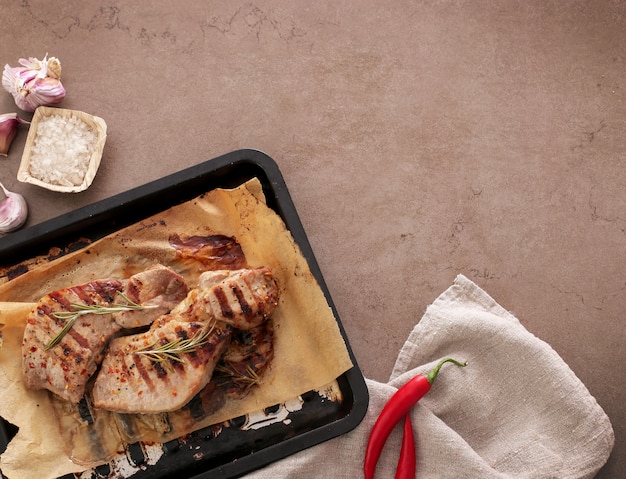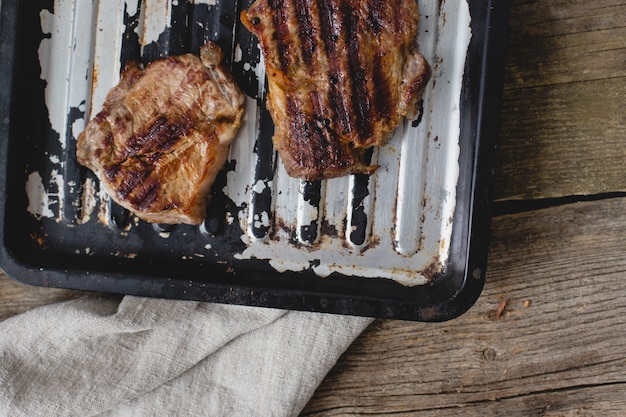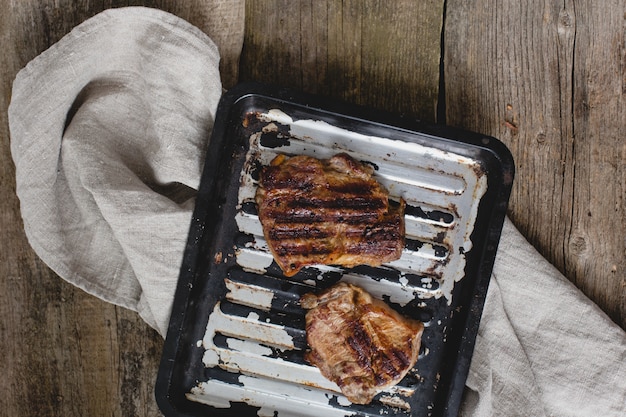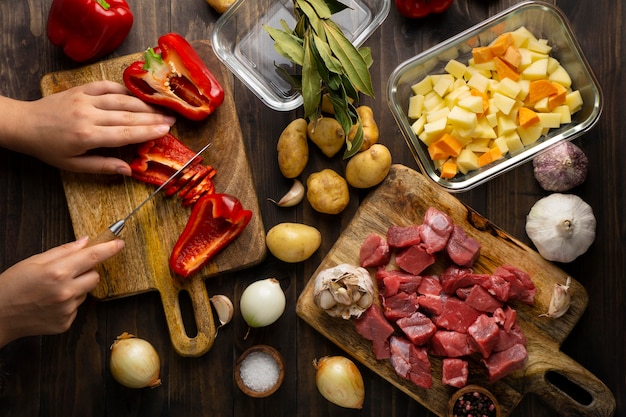Ah, prime rib. The crown jewel of roasts, the centerpiece of a celebratory feast, the ultimate comfort food on a chilly evening. Just the thought of that perfectly cooked, juicy, tender, and oh-so-delicious cut of beef sends a wave of anticipation through me. It's a dish that brings everyone together, fostering warmth and connection around the table. But let's be honest, achieving that picture-perfect prime rib isn't always a walk in the park. It requires a bit of knowledge, a touch of patience, and a whole lot of love – and that, my friends, is exactly what this guide is all about.
Over the years, I've cooked countless prime rib roasts, from intimate dinners with loved ones to grand celebrations with a roomful of guests. Along the way, I've learned a thing or two about roasting this magnificent cut of meat, and I'm thrilled to share all my secrets, tips, and tricks with you. This guide will lead you through every step, from selecting the perfect rib roast to mastering the cooking techniques. By the time you're done, you'll be a prime rib pro, ready to wow your family and friends with a meal worthy of royalty!
(Part 1) The Prime Rib: choosing the right cut

Let's start at the beginning, with the star of the show – the prime rib roast itself. The first decision you'll need to make is what kind of roast you want. You've got a couple of options here, and each has its own unique charm:
standing rib roast vs. Rib Roast
A standing rib roast is a whole rib roast, including the bones. It's a beautiful, impressive piece of meat that makes a statement on the table. Think of it as a showstopper, a grand display of culinary prowess. You can't help but feel a sense of occasion when you see a standing rib roast, and the aroma that fills the kitchen is truly captivating. It's perfect for a formal gathering or a special occasion.
On the other hand, a rib roast has had the bones removed. This makes it easier to carve and results in a more uniform cooking experience. It's a more practical option, ideal for everyday meals or casual gatherings. It's also a great choice if you're short on space in your oven.
Prime Rib vs. Ribeye
Now, let's talk about the actual cut of meat. You have two main options, both with distinct characteristics:
A prime rib roast is a cut of beef from the rib section, typically containing 3 to 7 ribs. It's known for its rich flavour and tender texture, making it the classic choice for prime rib roasts. It's the epitome of indulgence, a cut that melts in your mouth and leaves you wanting more.
A ribeye roast is a cut of beef from the ribeye muscle, which is located in the centre of the rib section. It's known for its marbling and buttery flavour, making it a delicious choice for a smaller gathering or a more intimate meal. Think of it as a slightly leaner, more delicate version of the prime rib, with a flavour profile that is both intense and sophisticated.
Choosing the Right Size
Next, comes the crucial decision of choosing the right size roast. Consider the number of guests you're serving and how much each person will likely eat. A good rule of thumb is to plan for about 1/2 pound of bone-in prime rib per person, or 1/4 pound of boneless prime rib per person.
Personally, I find a 3-rib roast perfect for a small gathering of 4-6 people, while a 4-rib roast is ideal for a larger group of 8-10 people. If you're planning a truly grand feast, a 7-rib roast is sure to make a statement! It's the ultimate "wow factor" for large gatherings.
(Part 2) Preparing Your Prime Rib Roast

Now that you've selected your prime rib, it's time to get ready for the cooking adventure! The preparation for a prime rib roast is quite simple, but there are a few key steps to ensure the best results.
1. Pat It Dry
Begin by patting the roast dry with paper towels. This step is crucial because it helps the roast brown evenly and prevents steam from building up during cooking. Excess moisture can make the roast tough, so a good pat down is essential.
2. Season to Perfection
Now comes the fun part: seasoning! While many people like to keep it simple with salt, pepper, and garlic powder, you can get creative and add other herbs and spices to enhance the flavour. I'm a big fan of rosemary, thyme, and paprika. The key here is to season generously, as the salt will draw out moisture from the meat, creating a more flavorful roast. Don't be afraid to get a good coating on the roast!
3. Rest in the Fridge
After seasoning your roast, cover it tightly with plastic wrap and refrigerate it for at least 4 hours, or preferably overnight. This allows the flavours to permeate the meat and creates a more tender roast. The time spent in the fridge allows the seasoning to work its magic, transforming your prime rib into a flavourful masterpiece.
(Part 3) Cooking Your Prime Rib Roast: A Comprehensive Guide

Now, for the moment of truth – cooking your prime rib roast! There are two main methods for cooking prime rib: roasting in the oven and cooking on a smoker. While both methods yield delicious results, I'm going to focus on oven-roasting, as it's the most common and generally the easiest for home cooks.
1. Preheat Your Oven
Preheat your oven to 450°F (232°C). This high temperature is crucial for searing the outside of the roast, creating a beautiful, crispy crust and locking in all those delicious juices. The intense heat creates a caramelized outer layer that adds depth and complexity to the flavour.
2. Roast It High
Place the roast on a roasting rack in a shallow roasting pan. This allows air to circulate around the roast, ensuring even cooking. Roast the roast for 15 minutes per pound, uncovered. This initial high-heat roast sears the exterior and forms that irresistible crust.
3. Lower the Heat
After 15 minutes per pound, reduce the oven temperature to 325°F (163°C) and continue roasting the roast for another 15-20 minutes per pound for medium-rare, 20-25 minutes per pound for medium, or 25-30 minutes per pound for medium-well. The lower temperature allows the roast to cook through evenly while maintaining its tenderness.
4. Rest It
Once the roast is cooked to your desired doneness, remove it from the oven and let it rest, covered with foil, for at least 15 minutes before carving. This allows the juices to redistribute throughout the meat, resulting in a more tender and flavorful roast. It's a crucial step in the process, allowing the meat to relax and absorb the juices that have been released during cooking.
(Part 4) Understanding Doneness and Using a meat thermometer
Getting the doneness of your prime rib just right is crucial for a delicious and enjoyable meal. Each level of doneness has its own unique texture and flavour, so understanding the differences is key to achieving your desired outcome.
prime rib doneness guide
| Doneness | internal temperature | Description |
|---|---|---|
| Rare | 125-130°F (52-54°C) | The centre of the roast will be very red, with a cool, soft texture. It's a very juicy and tender option, perfect for those who enjoy a bold, beefy flavour. |
| Medium-Rare | 130-135°F (54-57°C) | The centre of the roast will be pink, with a slightly firmer texture. This is a popular choice for many, offering a balance of tenderness and flavour. |
| Medium | 135-140°F (57-60°C) | The centre of the roast will be mostly brown, with a firmer texture. It's a more cooked option, with a slightly less juicy and more intense flavour. |
| Medium-Well | 140-145°F (60-63°C) | The centre of the roast will be brown throughout, with a firm texture. It's a well-cooked option, offering a drier and more intense flavour profile. |
| Well-Done | 145°F (63°C) and above | The centre of the roast will be brown and very firm. This is the most cooked option, offering a dry and intense flavour, but it can be a bit tougher. |
To ensure accurate doneness, it's essential to use a meat thermometer. Insert the thermometer into the thickest part of the roast, making sure it doesn't touch any bones. The thermometer should be inserted at a 45-degree angle to ensure you get an accurate reading.
Remember, the roast will continue to cook slightly after you remove it from the oven, so it's best to take it out when it's about 5-10 degrees below your desired doneness. This allows the roast to finish cooking while resting, ensuring that it reaches the perfect temperature.
(Part 5) Creating a Delicious Gravy
No prime rib experience is complete without a rich, flavorful gravy. And the best part is, it's surprisingly easy to make! Here's a simple recipe that will elevate your prime rib to new heights of deliciousness.
Ingredients
- 1/4 cup of butter
- 1/4 cup of all-purpose flour
- 4 cups of beef broth
- Salt and pepper to taste
Instructions
- Melt the butter in a saucepan over medium heat.
- Whisk in the flour and cook for 1 minute, or until the mixture is smooth and golden brown.
- Gradually whisk in the beef broth, making sure to remove any lumps.
- Bring the gravy to a simmer and cook for 5-10 minutes, or until it has thickened.
- Season with salt and pepper to taste.
To enhance your gravy even further, you can add a splash of red wine or Worcestershire sauce. For a more intense flavour, use the drippings from your roast to make the gravy. Simply strain the drippings into a fat separator and pour the clear liquid into the gravy. The drippings will add a depth of flavour that can't be replicated.
(Part 6) Serving Your prime rib masterpiece
Now, it’s time to enjoy the fruits of your labor! When your prime rib is done resting, carefully carve it into slices. The easiest way to carve a prime rib is to slice it perpendicular to the bones, creating beautiful, uniform slices. Serve the prime rib with your delicious homemade gravy, and let the feast begin!
Here are a few tips for serving your prime rib that will make your meal even more memorable:
- Carve the roast at the table. This adds a touch of theatre and allows guests to select their preferred level of doneness. It also creates a wonderful sense of anticipation and excitement.
- Serve the roast with a variety of sides. Potatoes, vegetables, and salads all make great companions for a prime rib roast. Think about the flavours that complement the rich, savory flavour of the roast.
- Don't forget the wine. A good red wine, like Cabernet Sauvignon or Merlot, pairs perfectly with prime rib. Choose a wine with bold fruit flavours and a smooth finish to complement the richness of the meat.
(Part 7) Troubleshooting: Common Prime Rib Problems and Solutions
Even the most experienced cooks can encounter a few challenges when preparing prime rib. Here are some common problems and solutions to help you troubleshoot your way to a perfect roast.
1. Overcooked Roast
If you’ve overcooked your prime rib, it’s likely to be dry and tough. While there’s not much you can do about this, you can try to salvage the roast by slicing it thinly and serving it with a rich gravy to add moisture. Next time, make sure to check the roast’s temperature regularly to ensure it doesn’t overcook.
2. Undercooked Roast
If your prime rib is undercooked, you can simply put it back in the oven for a few more minutes until it reaches your desired doneness. However, remember that the roast will continue to cook even after you remove it from the oven, so it’s best to err on the side of undercooking slightly. It's always better to have a slightly undercooked roast that you can finish cooking than an overcooked one.
3. Uneven Cooking
If your roast is unevenly cooked, it’s likely that you didn’t sear it properly or that you didn’t use a roasting rack. To prevent uneven cooking, ensure you sear the roast on all sides and use a roasting rack to allow air to circulate around the roast. This will help the roast cook evenly and prevent any parts from becoming overcooked.
(Part 8) Creative Prime rib recipes and Variations
Don’t be afraid to experiment with different flavours and techniques when preparing your prime rib roast. There are countless possibilities for creating unique and delicious dishes. Here are a few ideas to get you started, but feel free to let your creativity run wild!
1. Herb-Crusted Prime Rib
Combine your favourite herbs, such as rosemary, thyme, and parsley, with butter and spread it over the roast. Then roast as usual. The herb crust adds a fragrant and aromatic touch to the roast, creating a flavour explosion with every bite.
2. Garlic-Rosemary Prime Rib
Rub the roast with a mixture of garlic cloves, rosemary sprigs, salt, and pepper. Then roast as usual. The combination of garlic and rosemary creates a robust and savory flavour profile that is both comforting and sophisticated.
3. Maple-Glazed Prime Rib
Brush the roast with a maple syrup glaze during the last 30 minutes of cooking. The maple glaze adds a touch of sweetness and a beautiful sheen to the roast, creating a flavour that is both sweet and savory.
4. Smoked Prime Rib
For a truly unique flavour, consider smoking your prime rib. Use your favourite wood chips, such as hickory or applewood, to impart a smoky flavour to the roast. The smoky flavour adds a depth and complexity to the roast that is both delicious and satisfying.
(Part 9) FAQs about Prime Rib
1. What is the best way to store leftover prime rib?
Leftover prime rib should be stored in an airtight container in the refrigerator for up to 3-4 days. It's best to carve the prime rib into slices before storing it to ensure that it's properly chilled and that the flavour is retained.
2. Can I freeze prime rib?
Yes, you can freeze prime rib. Wrap the roast tightly in plastic wrap and then in aluminum foil, or use a freezer-safe bag. It can be frozen for up to 3 months. It's important to freeze the prime rib properly to prevent freezer burn and to preserve its quality.
3. What is the best way to reheat prime rib?
The best way to reheat prime rib is in a low oven (325°F/163°C) for 20-30 minutes, or until heated through. You can also reheat it in a slow cooker on low heat for 2-3 hours. Avoid reheating the prime rib in the microwave as it can make the meat dry and tough.
4. What are some good sides to serve with prime rib?
Some classic sides to serve with prime rib include mashed potatoes, roasted vegetables, Yorkshire pudding, and green bean casserole. However, you can also get creative and pair it with other sides that complement the richness of the roast, such as asparagus, Brussels sprouts, or butternut squash.
5. What is the best wine to pair with prime rib?
A full-bodied red wine, such as Cabernet Sauvignon, Merlot, or Zinfandel, pairs well with prime rib. However, you can also explore other options, such as a Syrah, a Malbec, or a Pinot Noir. Choose a wine that complements the flavour profile of your prime rib and your personal taste.
I hope this comprehensive guide has equipped you with all the knowledge you need to cook a delicious and impressive prime rib roast. Remember, the key to success is to plan ahead, choose the right cut, and follow the instructions carefully. And most importantly, don’t be afraid to experiment and have fun! Happy roasting!
Everyone is watching

Perfect Rice Every Time: The Ultimate Guide to Cooking Rice
Cooking TipsAs a self-proclaimed foodie, I've always been a bit obsessed with rice. It's the foundation of countless cuisi...

Ultimate Guide to Cooking the Perfect Thanksgiving Turkey
Cooking TipsThanksgiving. Just the word conjures up images of overflowing tables laden with delicious food, the scent of r...

The Ultimate Guide to Cooking Asparagus: Tips, Techniques, and Recipes
Cooking TipsAsparagus. The mere mention of this spring delicacy conjures up images of vibrant green spears, crisp and burs...

Can You Cook Spaghetti with Gasoline? (The Shocking Truth)
Cooking TipsWe've all seen those crazy internet trends. You know, the ones that make you wonder, "Did someone actually try...

Chorizo and Eggs Recipe: The Ultimate Guide
Cooking TipsRight, let’s talk about chorizo and eggs. You know, that classic Spanish dish that's always a winner. It's th...
